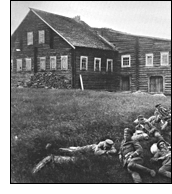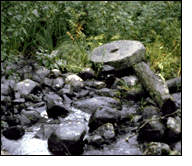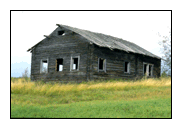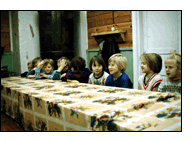 |
| Introduction |
| Poetry collecting |
| Lönnrot in Viena |
| Karelianism |
| Viena in the 1900's |
| Rune singers and collectors |
| Main page | Background | Villages | Revitalisation | Cultural tourism | Map | |
|
|
During the so-called "tribal wars" and following their conclusion in 1922, thousands of people moved from Viena to Finland. In 1923, when general amnesty was declared, most returned to their native villages. Life returned to normal until, in the early 1930s, a major change took place - the introduction of kolkhozi, or collective farms. In theory, joining a collective farm was voluntary, but in practice those who did not join were declared kulaks (greedy peasants) and punished in numerous ways, including expulsion from their native district. During the Continuation War (1941-44), the ravages of war spread to Karelia. Most of the population of Viena was evacuated - primarily to the Archangel region - in the face of advancing German and Finnish troops. In the Finnish-occupied area, of a original population of almost 12,000 persons, only some 600 remained in their villages. These movements of the population seriously eroded what had been a robust Karelian culture. Karelian families found themselves in an entirely Russian-speaking milieu, and many of the children forgot their mother tongue. Few families returned home intact. Before the war, the villages of Viena were exclusively Karelian; thereafter, people moved into the area from other parts of the Soviet Union, in particular Ukraine and White Russia (Belarus), where many of the villages and cities had been partially or totally destroyed.
People were not allowed back into all of the border villages after the war. However, many of the villages regained a certain vitality through the collective farms. In the late 1950s and early 1960s, as life was returning to normal, a new administrative decision took effect: collective farms at the village level were abolished, to be superseded by the new, mammoth Uhtua collective. This change was not only an administrative one, however, for the
small villages were actually eradicated as places to live. People
were ordered to move to the central villages of Vuokkiniemi and
Uhtua. Schools, shops and post offices were closed and the buildings
moved elsewhere. People were given In the late 1950s and early 1960s, most of the bardic villages in Viena were vacated. Since there was clearly not enough room for everyone in Vuokkiniemi or Uhtua, many people were simply relocated to forest "colonies" - villages of barracks usually located on flat, sandy tracts of forest and identical in appearance. Predictably, some people - young people in particular - moved to the cities or elsewhere in the country. Through 1956, pupils in the villages in Viena were taught in Finnish-medium schools. Thereafter, when the Karelo-Finnish Soviet Socialist Republic was abolished and replaced with the Karelian Autonomous Soviet Socialist Republic, a concerted policy of Russification was introduced. Instruction in the schools was entirely in Russian; the Department of Finnish at the University of Petrozavodsk was abolished; teachers in day-care centers were forbidden to speak to the children their mother tongue or native dialect. Thanks to the courageous and resolute efforts of Karelian writers
born in the bardic villages, the chair in the Finnish language was
reinstated at the University of Petrozavodsk in 1963, and the For decades, the crucial vehicles for the expression of national culture in Karelia have included the literary journal Carelia (formerly Punalippu) and the Karelian National Theater (formerly the Petrozavodsk Finnish Theater). In the mid 1980s, a Finnish-language children's magazine Kipinä (Spark) was started, and in 1991 the Kalevala district got its own Finnish-language magazine, Vienan Viesti (The Viena Gazette). That same year also marked the beginning of the regular publication of a Karelian-language newspaper, Oma mua, in Petrozavodsk. The policies of glasnost and perestroika that were pursued in the Soviet Union in the late 1980s provided an historic opportunity to begin the revitalization of the bardic villages of Viena. |
 For
the first two decades of this century, life in Viena continued as
it always had been, but in the years following the Russian Revolution
(1918-22), various armies marched through the villages with devastating
consequences: the Finns organized kinship crusades to "liberate"
Viena; the Bolsheviks defended their new political order; and the
English assembled an international legion to protect their trade
and other economic interests in the area.
For
the first two decades of this century, life in Viena continued as
it always had been, but in the years following the Russian Revolution
(1918-22), various armies marched through the villages with devastating
consequences: the Finns organized kinship crusades to "liberate"
Viena; the Bolsheviks defended their new political order; and the
English assembled an international legion to protect their trade
and other economic interests in the area. A
number of villages in Viena suffered the same fate. Tragically,
as members of the Resistance, Russian men had to burn the villages
of their birth.
A
number of villages in Viena suffered the same fate. Tragically,
as members of the Resistance, Russian men had to burn the villages
of their birth. financial
assistance to help in relocating their homes, because they were
not allowed to remain in the villages where they were born.
financial
assistance to help in relocating their homes, because they were
not allowed to remain in the villages where they were born. Finnish
language started gaining a foothold in other domains as well. In
the 1990s, the language programs of the University were expanded
to include course offerings in Karelian and Veps
Finnish
language started gaining a foothold in other domains as well. In
the 1990s, the language programs of the University were expanded
to include course offerings in Karelian and Veps